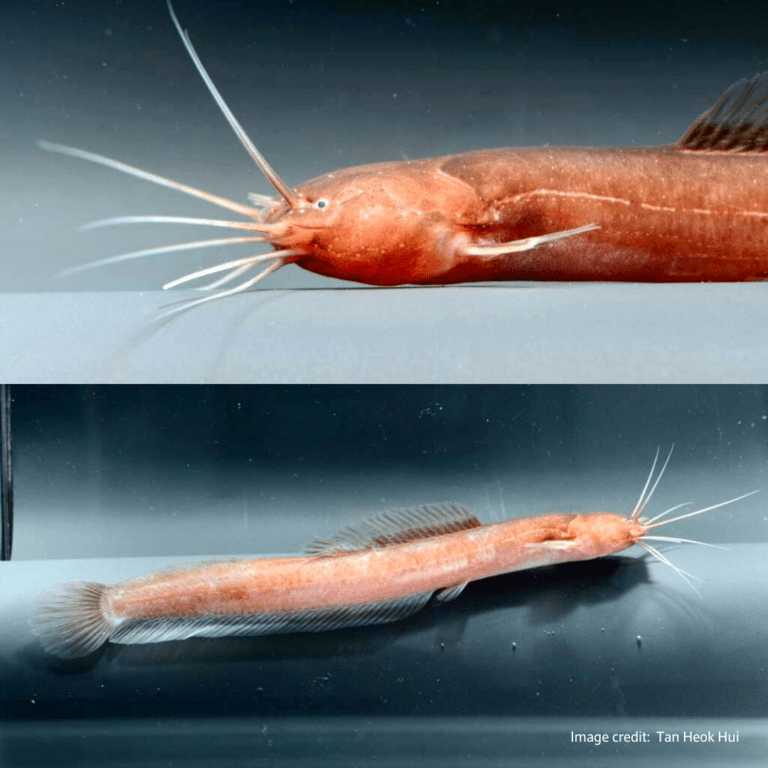News //
Recorded for the first time in Singapore, a previously unreported air-breathing clariid catfish has been sighted at Nee Soon Swamp Forest in the Central Catchment Nature Reserve (CCNR)! Published in the Raffles Bulletin of Zoology journal, the Museum and the National Parks Board have joined hands to document this Encheloclarias kelioides catfish. Associated more commonly with peat swamps in Malaysia and Indonesia, this elusive species is now known to be native to Singapore’s freshwater swamp habitat as well.

The discovery was made during a field survey for decapods in the area, when the then unidentified catfish was spotted by the keen eyes of Mr Tan Zhi Wan, a research assistant at LKCNHM and lead author of the paper, and Ms Elysia Toh, a Research Associate at Yale-NUS and co-author.
“We needed to be careful in checking that we hadn’t just seen a known, native Clarias species with a dorsal fin that had just been damaged. This is because Clarias species have dorsal fins that extend right down to the tail, whereas Encheloclarias species, like E. kelioides, have dorsal fins that are a bit shorter than that,” explained Mr Tan on his first impressions of the fish.
The pair did not have a permit to collect the specimen at the time, and released it after photographing it. Still, the sighting sparked the curiosity of the pair which led them to describe their observation to our Museum’s ichthyologist, Dr Tan Heok Hui. Dr Tan was surprised by what he saw in the photos, which left him asking for further verification—and with good reason, for E. kelioides was not previously known to exist here in Singapore! (Thankfully, the team was able to do several follow-up surveys of the area in collaboration with a colleague from the National Parks Board and with the necessary permit, and they managed to find more specimens of this same catfish!)

The acidic habitat of CCNR’s Nee Soon Swamp Forest is ecologically suitable for E. kelioides. Yet, despite the protected area’s long history of being monitored and sampled for freshwater fish species, this clariid catfish still remained undetected all these years!
On the ecological role of the E. kelioides catfish, Dr Tan highlighted their predatory significance in freshwater ecosystems like those of Nee Soon Swamp and CCNR. “The Clariidae family is a carnivorous one, allowing them to serve as predators that bring balance to the trophic structure,” the ichthyologist remarked. Assoc Prof Darren Yeo, Head of LKCNHM, also added that these catfish “may be helpful scavengers as well, contributing to freshwater swamp ecosystems by regulating the food web and facilitating nutrient cycling” in these environments. In retrospect, the fish’s cryptic presence thus far can be owed likely to its preference for thick, acidic peat substratum that allows it a secretive life beneath submerged leaf litter and root mats. Such tendencies of E. kelioides may have helped it to lay low not just in Singapore, but also in Southeast Asia more generally, making it one of the most poorly known Asian clariid catfish.
All in all, this remarkable discovery highlights the importance of conserving Nee Soon Swamp Forest as a place with significant potential for hidden surprises such as this and other future discoveries. Dr Cai Yixiong of the National Biodiversity Centre, NParks, and co-author on the paper, also conveyed that this latest publication has made recommendations for a revision of the species’ International Union for Conservation of Nature (IUCN) Red List assessment status. The team hopes that this will reflect its “national conservation status as critically endangered here in Singapore.”
Read the full paper here, or check out the story as covered by The Straits Times here.